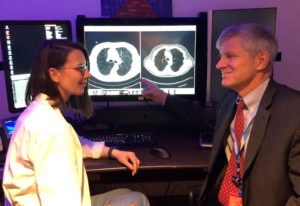 The landmark National Lung Screening Trial found that in high-risk individuals, low-dose CT (LDCT) screening reduced lung cancer mortality by 20 percent relative to chest X-ray. Nine years after those results were published, lung cancer remains by far the leading cause of cancer-related death. And yet, screening for this dangerous disease is lagging.
The landmark National Lung Screening Trial found that in high-risk individuals, low-dose CT (LDCT) screening reduced lung cancer mortality by 20 percent relative to chest X-ray. Nine years after those results were published, lung cancer remains by far the leading cause of cancer-related death. And yet, screening for this dangerous disease is lagging.
“About 95 percent of people nationally who should be screened aren’t being screened,” said thoracic surgeon Scott James Swanson, MD, of the The Lung Center at Brigham and Women’s Hospital. “It’s critical that patients understand when they should be screened and that doctors are more aggressive about screening their patients.”
To that end, Dr. Swanson and colleagues are setting out to raise awareness among clinicians and patients on the criteria for yearly lung screening with LDCT. They are also working to expand the Brigham’s capabilities for lung cancer screening and treatment.
More Resources Devoted to Fighting Lung Cancer
In January, the Brigham added two new CT scanners at its main campus. Previously, the system’s only CT scanners used for lung cancer screening were at Brigham and Women’s Faulkner Hospital in Boston’s Jamaica Plain neighborhood. Plans call for more CT scanners to be introduced to other Brigham and Women’s locations in the coming years.
The Brigham is also adding personnel to handle more lung cancer screenings, from staff who field calls from patients and referring physicians to a navigator who assists patients throughout screening and treatment. Suzanne C. Byrne, MD, staff radiologist in the chest radiology service in the Department of Radiology, has also joined The Lung Center’s team.
According to Dr. Swanson, the Brigham’s Lung Center is the first in the country to bring together a variety of specialists under one roof for lung cancer screening and treatment. The team includes pulmonologists, thoracic surgeons, medical and radiation oncologists, and diagnostic and interventional radiologists.
“Most patients who come here for screening will have no significant findings, meaning they just come back for their annual screening,” Dr. Byrne said. “But for patients with more serious findings, we can offer more multidisciplinary collaboration and discussion, ensuring they receive the optimal treatment for whatever is detected on their screening exams.”
A Measure of Reassurance
Dr. Swanson stressed that clinicians’ message to individuals at high risk for lung cancer should be upbeat:
- For patients who meet the criteria, screening is very effective in detecting lung cancer at an early stage
- The Lung Imaging Reporting and Data System (Lung-RADS®) by the American College of Radiology has standardized reporting of lung cancer screening studies and management recommendations, which helps to lower the incidence of unnecessary surgery for noncancerous conditions
- Chemotherapy and radiation therapy are needed in increasingly fewer cases
- Enhanced surgical techniques have reduced complications and recovery time while improving survival
“At the Brigham, we do 94 percent of our lung cancer surgeries minimally invasively, compared with national rates of around 40 percent,” Dr. Swanson said. “By doing less-invasive surgery, you suppress the immune system less. This allows the patient’s own immune system to work better at surveilling or taking care of any cancer cells leftover after surgery.”
Having expertise in minimally invasive techniques also enables centers like the Brigham to perform lung cancer surgery on a wider span of patients.
“People who are elderly, have a bad heart or can’t breathe well generally can’t have an open operation because the risks are too high. Therefore, even if you found something upon screening, you wouldn’t be able to offer surgery,” Dr. Swanson explained. “But very few patients can’t handle a minimally invasive operation. So at a center like ours, we can perform surgery on more people who need it. And if they do have the operation, they’ll have a better outcome.”
Dr. Swanson said that primary care physicians or other clinicians who need assistance interpreting CT scans or determining treatment plans are welcome to contact his team. The Lung Center is also available to manage follow-up appointments with patients who need treatment. Their goal is to help more patients at the Brigham and beyond to enjoy the benefits of earlier detection of and treatment for lung cancer.
For perspective on the importance of lung cancer screening, Dr. Swanson quoted his colleague, Jacob Sands, MD, a medical oncologist at the Dana-Farber Cancer Institute: “It’s like Jacob says: If we could completely cure breast cancer, we still wouldn’t save as many lives as if all the [high-risk] patients in the U.S. were screened for lung cancer.”